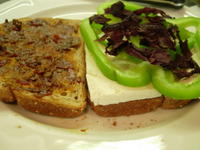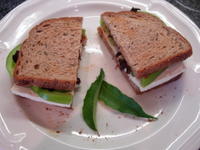Three Salads and Dressings
Recipes:
1. Tossed Lasagne Bits Salad w/ Lemon Zest, Olive Oil, and Parmesan Cheese
- Diet Direction: Cleansing
- % Calories from Fat = 12%
- % Calories from Carbohydrates = 75%
- % Calories from Protein = 13%
2. Composed Butter Lettuce & Arugula Salad with Satsuma Segments and Tomato-Sage Chutney & Yogurt Dressing
- Diet Direction: Balancing
- % Calories from Fat = 32%
- % Calories from Carbohydrates = 56%
- % Calories from Protein = 11%
3. Warmed Spinach and Escarole Salad w/Shallot, White Wine, and Dill Dressing
- Diet Direction: Higher-Fat/Lower-Protein Building
- % Calories from Fat = 62%
- % Calories from Carbohydrates = 18%
- % Calories from Protein = 20%
4. EXTRA: Garbanzo Bean Salad w/Onions, Oregano and No-Chicken Broth
- Diet Direction: Cleansing
- % Calories from Fat = 19%
- % Calories from Carbohydrates = 65%
- % Calories from Protein = 16%
The Experience:
Recipe #1: Tossed Salad
Well if there was ever an excuse for the “accidental salad” this has to be it. This salad “emerged” after I boiled too many lasagna noodles for a freshly-made lasagna dish I was working on. Not wanting to throw the extra noodles away I wondered how I could make use of them. I also had some fresh olive oil I had just bought that was very flavorful. So I decided then to make a tossed pasta salad, using the lasagna noodles cut up into small ½” bits, along with some olive oil, fresh oregano, parmesan reggiano, and some lemon zest for a little spunk. Initially, it tasted a little bitter (because of the oregano and parmesan I thought). So I added a little rapadura, and this seemed to even the flavour out. I served it more like an “amise bouche”, on small plates. It went off extremely well! This recipe is a definite “keeper”!
Recipe #2: Composed Salad
We recently had a salad in class with orange segments, so I felt that I had to do something with oranges. I looked for the freshest greens in Whole Foods and found some beautiful butter lettuce and “muddied” Arugula – perfect! Satsuma oranges were also fresh, so that took care of my orange fetish-of-the-week. Lastly, I had made lasagna and had all this tomato peel and seeds available to me – so presto, a chutney was born.

"Composing" a Composed Salad
(Chef Patañjali "in-the-works")
But to make things interesting, I decided to use more “western” herbs, and settled for Sage. The Tomato-Sage chutney turned out well, and had a very unique flavor, unlike any other chutney I had made before. But I wanted to drizzle the dressing on the composed salad, so I mixed the chutney with some yogurt to create a spicy-creamy combination. I layered the salad greens, placed the Satsuma segments on top, and drizzled over it with the dressing just before serving. People raved at the combination of spice (chutney), bitterness (arugula), and butter lettuce. It really was both fun to make and very delicious. Also a definite “keeper” for my recipe book.
Recipe #3: Warmed Salad
I use one rule of thumb, not only when I make salads, but also in general, when I go shopping for ingredients. Whatever is the freshest, I just buy it, and make use of it in something. This was true with the spinach at Rainbow Co-Op the other day. The spinach was extraordinarily green and fresh, and so it became the focal point of my warmed salad. I used some leftover escarole as a base, and massaged-in some olive oil and set aside. This was something we did with kale some time ago, and I wondered how it would work with escarole. I also wanted to make use of some dill, as my wife, Jasmin, had said that it was one of those herbs she really liked. With shallots and butter in hand, I created a sauté and reduced it with some leftover white wine. The dill blended marvelously with the wine-reduced shallots. Blending it with yogurt created a beautiful creamy dressing sensation. This salad was also a composed one.

Warmed Spinach and Escarole Salad
w/Shallot, White Wine, and Dill Dressing
The escarole served as the base. I warmed some spinach leaves in a frypan (no oil, just some heat) and placed them on top of each plate of escarole leaves. The dressing followed on top. I finished it off with some grated mozzarella cheese. Somehow, this was truly one of the best salads I had created. There was complete silence at the table as people consumed. This one surely has some great potential!
Recipe #4 (EXTRA): Warmed Garbanzo Bean Salad
I wanted to use garbanzo beans as a starter so I decided to make a warmed salad with garbanzo beans and oregano. To bring out the flavour of the beans, I added sautéed onions, white wine, and completed it with a no-chicken broth reduction. The use of fresh oregano in the final stages provided an amazing aroma to the dish. I used goat cheese as an optional garnish at the end. I really liked the texture of the goat cheese with the garbanzo beans. However, goat cheese can sometimes tend to be overpowering. In future, I might try another cheese that has a similar consistency to goat cheese, but doesn’t have the same flavour. I wonder how mild ricotta cheese would be? Mmmm. I like it already!
Health Benefits
Oregano
Oregano is one of the most beneficial herbs in existence. In addition to having high anti-inflammatory properties, and the ability to stimulate bile production (aiding in digestion), its oils have painkilling properties as powerful as morphine!! Their anti-oxidant powers are well-documented. For example, fresh oregano is known to have antioxidant capabilities that are : “… 42 times more antioxidant activity than apples, 30 times more than potatoes, 12 times more than oranges and 4 times more than blueberries.” In addition to having anti-bacterial properties that bind to free radicals and cancer-causing toxins in the colon, fresh oregano is also high in fiber. From the looks of it, an “apple a day, might keep the doctor/cancer away”, but an “ounce of oregano, can keep a lifetime of agony away”. I’m stalking up on my oregano right now!
Dill Weed
Surprisingly, dill weed has a healthy dose of calcium, making it a great herb to help treat bone loss. It also protects against free-radical damage and prevents the growth of bad-bacteria. Dill has a long, global history. Its roots go as wide as Russia, Asia, and the Middle East. Hippocrates, known as the father of modern medicine, used dill in a recipe to clean the mouth of bacteria and germs. Forget listerine, this is one tasty mouthwash!!
Sage
Another wonder herb, used in Europe for over 2000 years (!!), sage, is known to help with many stomach-related ailments, such as indigestion, and lack of appetite. In fact, the German government recognizes the herb as an officially sanctioned stomach remedy! It also protects against oral inflammation, perspiration, rhinitis and sore throats. Like rosemary, sage is also known as an outstanding memory enhancer. Its anti-inflammatory properties also help reduce concentrations of inflammatory molecules, such as leukotriene B4, a key cause of oxygen-related damage to cells. In general, sage is an amazing herb, with phenomenal healing properties.
References
- The Wolfe Clinic: http://www.thewolfeclinic.com/oregano.html
- World’s Healthiest Foods: http://www.whfoods.com/genpage.php?tname=foodspice&dbid=73
- World’s Healthiest Foods: http://www.whfoods.com/genpage.php?tname=foodspice&dbid=71
- St. Joseph’s Health Institute, Hamilton, ON: http://www.stjosham.on.ca/nutrition/spices.htm#dill
- What Really Works.com: http://www.whatreallyworks.co.uk/start/articles.asp?article_ID=920
- World’s Healthiest Foods: http://www.whfoods.com/genpage.php?tname=foodspice&dbid=76









